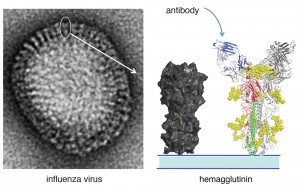
While it's not done this way anymore, getting a flu vaccine every year can still be a pain. Stephen Harrison is working on a vaccine strategy that would protect against flu strains from multiple seasons. (Photo: cdc e-health/Flickr)
Every year, the flu tries to outwit humanity. By shifting parts of its outer coat, the virus renders the flu vaccine from the previous year obsolete, bringing another season of misery. And every year, we fight back with a new vaccine, finding a new chink in the virus’s armor and giving ourselves another brief window of protection.
But if Stephen Harrison, chief of Children’s Division of Molecular Medicine, is right, we might be able to train our immune systems to look past the flu virus’s annual trickery and build up resistance that spans multiple seasons. That could reduce the need to develop, produce, and distribute a new flu vaccine nearly every year, a process of selection, growth, packaging, and distribution that can take upwards of seven months.
An influenza protein called hemagglutinin, the primary target of the seasonal flu vaccine, is the key by which the influenza virus unlocks human cells; it binds to sialic acid on cell surfaces and helps the virus get access to the cell’s synthetic machinery, which the virus uses to churn out thousands of copies of itself. As a vaccine target, hemagglutinin works well – so well that in order to remain viable, the virus has to mutate the protein every year, evading recognition by the antibodies we produce in response to the vaccine. This evasion strategy, called antigenic drift, is why a new flu vaccine is necessary every year.
But it turns out that the immune system is able on its own to mount a relatively minor attack against parts of hemagglutinin that don’t change every year, producing antibodies that work against multiple flu strains, according to a recent paper by Harrison and collaborators at Duke University Medical Center in the Proceedings of the National Academy of Sciences. Could this response be enhanced, creating a flu vaccine that lasts through multiple seasons?
Harrison’s team studied B cells (the immune cells tasked with antibody production) donated by an individual who had received the 2007 flu vaccine. Using a suite of genomic tools, they analyzed the antibody genes and produced a panel of antibodies that bound to and neutralized hemagglutinin proteins from several years’ worth of influenza virus. One antibody in particular, which the team dubbed CH65, attached itself to hemagglutinin from 30 out of the 36 viral strains against which the team tested it.
“While it’s unusual to find such broadly effective antibodies to the flu virus, they may actually be more common than we realize,” Harrison says. “What this tells us is that the human immune system can fine-tune its response to the flu and actually produce, albeit at a low frequency, antibodies that neutralize a whole series of strains.”
By comparing CH65 and the other antibodies produced from the donated cells, Harrison’s team was able to glimpse how the donor’s immune response against the flu virus had evolved over time, fine-tuning itself over the course of multiple exposures until settling on a group of antibodies, including CH65, that mimicked key aspects of sialic acid and bound to portions of hemagglutinin that the virus cannot mutate without reducing its ability to infect human cells.

There are a lot of places on hemagglutinin (the black knobby protein in the middle) where an antibody can bind. Can we convince the immune system to only go for the places that don't mutate? (click to enlarge)
With this knowledge, Harrison believes it may be possible to develop vaccines that actively guide the immune system into the kind of evolved response that happened naturally in the case of CH65 – one that protects against multiple strains of the influenza virus by targeting the same un-mutatable portions of hemagglutinin. To do so, he wants to understand from a chemical and structural standpoint the step-by-step events that take place as an immune response against hemagglutinin evolves over time. He also wants to survey the cells of more flu vaccinees to find out whether the immune system naturally produces these kinds of broadly active antibodies more frequently than we currently recognize.
“Developing a flu vaccine is currently a hit-or-miss enterprise,” says Harrison. “We vaccinate with a virus or part of a virus and hope that the immune response will evolve in a useful direction. But for viruses like influenza that mutate rapidly, we want to have a response that does a really good job at blocking the strain of the virus in the vaccine and many related strains as well. These results point out what strategies we might employ to achieve that goal.”
Whittle, J., Zhang, R., Khurana, S., King, L., Manischewitz, J., Golding, H., Dormitzer, P., Haynes, B., Walter, E., Moody, M., Kepler, T., Liao, H., & Harrison, S. (2011). Broadly neutralizing human antibody that recognizes the receptor-binding pocket of influenza virus hemagglutinin Proceedings of the National Academy of Sciences DOI: 10.1073/pnas.1111497108








